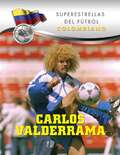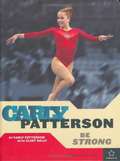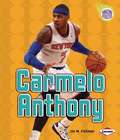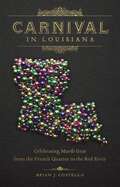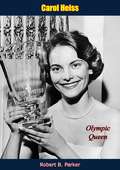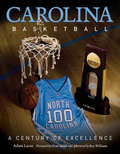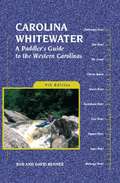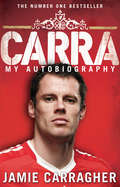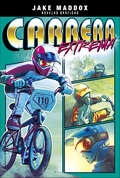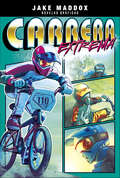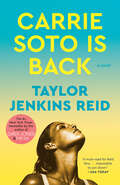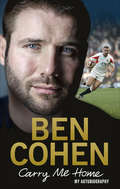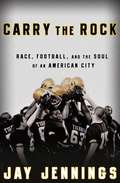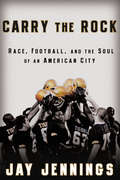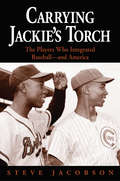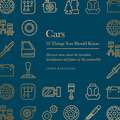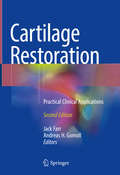- Table View
- List View
Carlos Valderrama (Superstars of Soccer SPANISH)
by Juan Domingo ChacoffEl año 2004 marcó el centenario de la fundación de la FIFA. Para celebrar este hito, Pelé, el legendario estrella brasileño, compiló una lista de los más grandes jugadores vivos. La lista incluyó sólo un colombiano: Carlos "El Pibe" Valderrama. Pocos aficionados informados tendrían problemas con la inclusión de Valderrama. El mediocampista está considerado como el mejor jugador en la historia del fútbol colombiano. Jugó en un nivel récord de 111 partidos con la Selección Nacional de Colombia. También brilló en las ligas de América del Sur, Europa y los Estados Unidos. El Pibe se retiró en 2004 después de una carrera brillante de 25 años.
Carlos Valderrama (Superstars of Soccer)
by Juan Domingo ChacoffEl año 2004 marcó el centenario de la fundación de la FIFA. Para celebrar este hito, Pelé, el legendario estrella brasileño, compiló una lista de los más grandes jugadores vivos. La lista incluyó sólo un colombiano: Carlos "El Pibe" Valderrama. Pocos aficionados informados tendrían problemas con la inclusión de Valderrama. El mediocampista está considerado como el mejor jugador en la historia del fútbol colombiano. Jugó en un nivel récord de 111 partidos con la Selección Nacional de Colombia. También brilló en las ligas de América del Sur, Europa y los Estados Unidos. El Pibe se retiró en 2004 después de una carrera brillante de 25 años.
Carly Patterson
by Jeff SavageCarly Patterson electrified audiences with her performance at the 2004 Olympic Games in Athens, Greece. Displaying amazing poise, this sixteen-year-old helped the U.S. women's gymnastics team win the silver medal in the team competition and she also won an individual silver in her best apparatus, the balance beam. But Carly's biggest moment came when she beat out some of the world's top gymnasts to win gold in the all-around competition. Read about the best female gymnast at the 2004 Olympic Games.
Carly Patterson: Be Strong
by Carly Patterson Clint KellyCarly Patterson writes about her journey to Olympic Gold.
Carmelo Anthony
by Aurelia JacksonCarmelo Anthony is one of the biggest stars in the NBA. A six-time NBA All-Star, Carmelo's time in the league has been a dream-come-true. From playing with the Knicks in Madison Square Garden to playing on the U.S. Olympic team, Carmelo has proven that he's at the top of the basketball world. Learn the story of one of the NBA's most popular players. Find out how he worked hard to realize his childhood dreams of playing basketball in the NBA--and discover how today, he shares his success with others!
Carmelo Anthony (Amazing Athletes)
by Jon M. FishmanCarmelo Anthony led his college basketball team to victory in the national championship game, then helped turn the Denver Nuggets into a winning team. Learn more about one of the NBA's biggest stars.
Carnival in Louisiana: Celebrating Mardi Gras from the French Quarter to the Red River
by Brian J. CostelloFrom the revelers on horseback in Eunice and Mamou to the miles-long New Orleans parade routes lined with eager spectators shouting “Throw me something, mister!,” no other Louisiana tradition celebrates the Pelican State’s cultural heritage quite like Mardi Gras. In Carnival in Louisiana, Brian J. Costello offers Mardi Gras fans an insider’s look at the customs associated with this popular holiday and travels across the state to explore each area’s festivities.Costello brings together the stories behind the tradition, gleaned from his research and personal involvement in Carnival. His fascinating tour of the season’s parades, balls, courirs, and other events held throughout Louisiana go beyond the well-known locales for Mardi Gras. Exploring the diverse cultural roots of state-wide celebrations, Costello includes festivities in Lafayette, Baton Rouge, New Roads, and Shreveport. From venerable floats to satirical parades, exclusive events to spontaneous street parties, Carnival in Louisiana is an indispensable guide for Mardi Gras attendees, both veteran Krewe members seeking to expand their horizons and first-time tourists hoping to experience of all sides of Louisiana’s favorite season.
Carol Heiss: Olympic Queen
by Robert B. ParkerCarol Heiss is a two-time Olympic medalist and five-time world champion in figure skating. She won the 1960 Olympics in women’s figure skating and she also won the silver medal at the 1956 Olympics. When she won the 1960 Olympic Gold Medal, all nine judges awarded her first place. Carol Heiss won the world championship every year from 1956 through 1960.This biography on the famous American former figure skater and actress, written by the well-known private detective novelist Robert Parker, was first published in 1961.Richly illustrated throughout with photographs.
Carolina Basketball
by Adam LucasBoasting six national championships and scores of Hall of Fame coaches and players, Carolina Basketball has come a long way from the first season--when the campus newspaper published a notice asking an unknown culprit to return the team's basketball. These pages are packed with little-known stories from the program's earliest days and new insights into its best-loved moments. All the greats are here, from Jack Cobb and the "Blind Bomber" George Glamack to Lennie Rosenbluth, Phil Ford, James Worthy, Michael Jordan, Antawn Jamison, and Tyler Hansbrough. Lucas reveals the meaning of the "Carolina family" and the origins and evolution of Tar Heel traditions that have made North Carolina one of the premier teams in men's college basketball. These stories are brought to life with more than 175 color and black-and-white photos; a foreword by Hall of Fame coach Dean Smith and an afterword by fellow Hall of Famer Roy Williams; and an appendix of records and statistics. Some 25 sidebars feature first-person recollections from prominent players, including Rosenbluth, Ford, and Jordan; opposing coaches like Lefty Driesell; and famous alumni like Peter Gammons and Alexander Julian. This is the must-have book for Tar Heel fans and college basketball lovers everywhere.
Carolina Whitewater
by Bob Benner David BennerThe ultimate guide to paddling whitewater in the western Carolinas, Carolina Whitewater has guided boaters to the best water in the Tar Heel and Palmetto states for almost 30 years. This latest edition includes expanded and updated information for the classic rivers, like the Chattooga, French Broad, and Nantahala, in addition to many new steep creeks including Cove, Rockhouse, and Hurricane. New to this edition is a section on flatwater that is suitable for canoe camping and can be handled by beginner and novice paddlers. Profiled runs are from the Broad River and two of its tributaries, the Enoree and the Tyger. The convenient at-a-glance format for each river section makes it easy to find critical details such as difficulty, length, paddling time, gradient, and more. River descriptions, shuttle and gauge information, and topographic-based maps complete the useful information needed to help boaters pick rivers to match their ability. With over 80 detailed profiles and more than 60 maps of the best canoeing and kayaking waterways in the Carolinas, this guide is indispensable. From quiet float trips on the French Broad to exciting runs on the fast-flowing Nolichucky, Carolina Whitewater details the best paddling experiences in both states.
Carra: My Autobiography
by Jamie CarragherFor the Anfield faithful, Jamie Carragher represents everything that is great about Liverpool Football Club, prompting the Kop to sing 'we all dream of a team of Carraghers'. The club's vice-captain, longest-serving player and one of a select band of players to have made more than 500 appearances for the Reds, Carra never gives less than 100 per cent for the cause. He is the embodiment of old-fashioned football values - a rarity in the modern game - honest and uncompromising.In Carra: My Autobiography, the Liverpool defender takes us deep into the heart of Anfield, into the club's past glories and its uncertain future. In his typically down-to-earth style, Carra reveals what made him discard his blue Evertonian roots to become a fully fledged Red, how he mended his wild ways to become a true professional and a multiple trophy-winner, and the truth about a succession of managers - Evans, Houllier, Benítez - in the hottest seat in football. A Scouser through and through, Carra also has some forthright views on the England team, and tells why he rejected calls to return to the international fold.Full of sensational stories and controversial opinions, of glory and heartbreak on and off the pitch, Carra: My Autobiography is a football book unlike any other. The authentic voice of Anfield, Carra is one of the Bootroom Boys in true Liverpool tradition, and is as committed on the page as in every game he has played.
Carrera extrema (Jake Maddox Novelas Gráficas)
by Jake MaddoxNelson Greenwood loves BMX racing, almost as much as he loves to draw superheroes. The hero of his own comic book, Major Speed, isn't afraid of anything, much like Nelson's twin brother Nick. Nelson looks up to Nick and his mad BMX skills. But when a rough crash keeps Nick out of the BMX-Treme Competition, he suggests that Nelson take his place. However, Nelson doesn't think he has what it takes to compete against the best racers in the city - especially Nick's nemesis, Cain Otto. Can Nelson shift gears and muster the courage and strength of Major Speed to compete in the race? Combining a high-stakes sports story with a dynamic full-color comic format, this Jake Maddox Graphic Novel is sure to be a win for young athletes and struggling readers alike. Fully translated Spanish text.
Carrera extrema (Jake Maddox Novelas Gráficas)
by Jake MaddoxNelson Greenwood loves BMX racing, almost as much as he loves to draw superheroes. The hero of his own comic book, Major Speed, isn't afraid of anything, much like Nelson's twin brother Nick. Nelson looks up to Nick and his mad BMX skills. But when a rough crash keeps Nick out of the BMX-Treme Competition, he suggests that Nelson take his place. However, Nelson doesn't think he has what it takes to compete against the best racers in the city - especially Nick's nemesis, Cain Otto. Can Nelson shift gears and muster the courage and strength of Major Speed to compete in the race? Combining a high-stakes sports story with a dynamic full-color comic format, this Jake Maddox Graphic Novel is sure to be a win for young athletes and struggling readers alike. Fully translated Spanish text.
Carrera extrema (Jake Maddox novelas gráficas)
by Jake MaddoxNelson Greenwood loves BMX racing, almost as much as he loves to draw superheroes. The hero of his own comic book, Major Speed, isn't afraid of anything, much like Nelson's twin brother Nick. Nelson looks up to Nick and his mad BMX skills. But when a rough crash keeps Nick out of the BMX-Treme Competition, he suggests that Nelson take his place. However, Nelson doesn't think he has what it takes to compete against the best racers in the city - especially Nick's nemesis, Cain Otto. Can Nelson shift gears and muster the courage and strength of Major Speed to compete in the race? Combining a high-stakes sports story with a dynamic full-color comic format, this Jake Maddox Graphic Novel is sure to be a win for young athletes and struggling readers alike. Fully translated Spanish text.
Carreras de larga distancia (¡Arriba la Lectura! Level O #2)
by Diana NoonanNIMAC-sourced textbook <p><p> Las carreras de larga distancia son algo que disfrutan tanto los adultos como los niños. Los corredores viajan a distintos países para participar en este tipo de evento deportivo. Descubre los tipos de carreras de larga distancia que se organizan en todo el mundo.
Carrie Soto Is Back: A Novel
by Taylor Jenkins ReidNATIONAL BESTSELLERNEW YORK TIMES BESTSELLERIn this powerful novel about the cost of greatness, a legendary athlete attempts a comeback when the world considers her past her prime--from the New York Times bestselling author of Malibu Rising.Carrie Soto is fierce, and her determination to win at any cost has not made her popular. But by the time she retires from tennis, she is the best player the world has ever seen. She has shattered every record and claimed twenty Grand Slam titles. And if you ask Carrie, she is entitled to every one. She sacrificed nearly everything to become the best, with her father, Javier, as her coach. A former champion himself, Javier has trained her since the age of two.But six years after her retirement, Carrie finds herself sitting in the stands of the 1994 US Open, watching her record be taken from her by a brutal, stunning player named Nicki Chan.At thirty-seven years old, Carrie makes the monumental decision to come out of retirement and be coached by her father for one last year in an attempt to reclaim her record. Even if the sports media says that they never liked the "Battle-Axe" anyway. Even if her body doesn&’t move as fast as it did. And even if it means swallowing her pride to train with a man she once almost opened her heart to: Bowe Huntley. Like her, he has something to prove before he gives up the game forever.In spite of it all, Carrie Soto is back, for one epic final season. In this riveting and unforgettable novel, Taylor Jenkins Reid tells her most vulnerable, emotional story yet.
Carry Me Home: My Autobiography
by Ben CohenBen Cohen’s dad didn’t know anything about the sport his young son had taken up, but he was happy to drive him to practice, and was soon helping out at the club. When his business went bankrupt money was tight, but Ben’s hard working parents inspired their son to put his all into rugby.Then, when Ben was 20, his father intervened in a fight in the nightclub where he worked. He was viciously beaten and one month later he died in hospital. Ben was doing an England press conference at the time, and it was down to coach Clive Woodward to deliver the devastating news. But the ordeal was far from over. The inquest lasted five months before the funeral could be held, and it was a year before the family were in court, facing Peter’s assailants.Ben put all of the anger and pain from his father’s death into his rugby. Fast and powerful on the wing, he was soon the best in the world in his position and a cornerstone of the England team, culminating in the legendary World Cup win in Sydney in 2003. And yet he always felt like an outsider. Most people didn’t know that Ben is clinically deaf. His sixth sense for the game got him through on the pitch, but off it his poor hearing was often taken for arrogance.This is an inspirational story of passion and pain; of the highs of achieving your goals, and the grief of losing something you can never get back.
Carry the Rock: Race, Football, and the Soul of an American City
by Jay JenningsIn 1957, nine African American teenagers faced angry mobs and the resistance of a segregationist governor to claim their right to educational equality. The bravery of the Little Rock Nine, as they became known, captured the country's imagination and made history but created deep scars in the community. Jay Jennings, a veteran sportswriter and native son of Little Rock, returned to his hometown to take the pulse of the city and the school as the fiftieth anniversary of the integration fight approached. He found a compelling story in the school's football team, where black and white students came together under longtime coach Bernie Cox, whose philosophy of discipline and responsibility and punishing brand of physical football know no color. A very private man, Cox nevertheless allowed Jennings full access to the team, from a preseason program in July through the Tigers' final game in November. As in A Season on the Brink, the coach finds his ideas sorely tested in his attempts to unify the team, and the result is a story brimming with humor, compassion, frustration, and honesty. As Carry the Rock chronicles the dramatic ups and downs of a high school football season, it reveals a city struggling with its legacy of racial tension and grappling with complex, subtle issues of contemporary segregation. What Friday Night Lights did for small-town Texas, Carry the Rock does for the urban south and for any place like Little Rock, where sports, race, and community intersect.
Carry the Rock: Race, Football, and the Soul of an American City
by Jay JenningsIn 1957, nine African American teenagers faced angry mobs and the resistance of a segregationist governor to claim their right to educational equality. The bravery of the Little Rock Nine, as they became known, captured the country's imagination and made history but created deep scars in the community.Jay Jennings, a veteran sportswriter and native son of Little Rock, returned to his hometown to take the pulse of the city and the school as the fiftieth anniversary of the integration fight approached. He found a compelling story in the school's football team, where black and white students came together under longtime coach Bernie Cox, whose philosophy of discipline and responsibility and punishing brand of physical football know no color. A very private man, Cox nevertheless allowed Jennings full access to the team, from a preseason program in July through the Tigers' final game in November.In the season Jennings masterfully chronicles, the coach finds his ideas sorely tested in his attempts to unify the team, and the result is a story brimming with humor, compassion, frustration, and honesty. Carry the Rock tells the story of the dramatic ups and downs of a high school football season, and it reveals a city struggling with its legacy of racial tension and grappling with complex, subtle issues of contemporary segregation. What Friday Night Lights did for small-town Texas, Carry the Rock does for the urban south and for any place like Little Rock, where sports, race, and community intersect.
Carrying Jackie's Torch: The Players Who Integrated Baseball—And America
by Steve JacobsonThe real and painful struggles of the black players who followed Jackie Robinson into major and minor league baseball from 1947 to 1968 are chronicled in this compelling volume. Players share their personal and often heart-wrenching stories of intense racism, both on and off the field, mixed with a sometimes begrudged appreciation for their tremendous talents. Stories include incidents of white players who gave up promising careers in baseball because they wouldn't play with a black teammate, the Georgia law that forbade a black player from dressing in the same clubhouse as the white players, the quotas for the number of blacks on a team, and how salary negotiations without agents or free agency were akin to a plantation system for both black and white players. The 20 players profiled include Ernie Banks, Alvin Jackson, Charlie Murray, Chuck Harmon, Frank Robinson, Bob Gibson, Hank Aaron, Curt Flood, Lou Brock, and Bob Watson.
Cars: 10 Things You Should Know
by Lewis KingstonDiscover more about the invention, development and future of the automobile in 10 captivating essays for those with a need for speed!Cars have shaped our world, giving us the freedom to travel and changing the pace of life as we know it. But how were cars created? How does fuel get us from A to B? And what will cars look like in years to come?From understanding how cars were first produced, to showing how cars are adapting for our environment, and even helping you to choose a vehicle that's right for you, this book is the essential guide to understanding how automobiles continue to shape our lives.
Cars: 10 Things You Should Know
by Lewis KingstonDiscover more about the invention, development and future of the automobile in 10 captivating essays for those with a need for speed!Cars have shaped our world, giving us the freedom to travel and changing the pace of life as we know it. But how were cars created? How does fuel get us from A to B? And what will cars look like in years to come?From understanding how cars were first produced, to showing how cars are adapting for our environment, and even helping you to choose a vehicle that's right for you, this book is the essential guide to understanding how automobiles continue to shape our lives.
Cars: 10 Things You Should Know
by Lewis KingstonDiscover more about the invention, development and future of the automobile in 10 captivating essays for those with a need for speed!Cars have shaped our world, giving us the freedom to travel and changing the pace of life as we know it. But how were cars created? How does fuel get us from A to B? And what will cars look like in years to come?From understanding how cars were first produced, to showing how cars are adapting for our environment, and even helping you to choose a vehicle that's right for you, this book is the essential guide to understanding how automobiles continue to shape our lives.
Cartilage Restoration: Practical Clinical Applications
by Andreas H Gomoll Jack FarrAttempting to bridge the gap between the science and art of cartilage restoration, Cartilage Restoration: Practical Clinical Applications combines an overview of clinical research and methodologies with clinical cases to help guide the orthopedic treatment and care of patients presenting with cartilage issues. With chapters written by internationally-renowned orthopedic surgeons, topics include an overview of current surgical options, debridement and marrow stimulation, autograft plug transfer, allografts, cell therapy, and meniscal issues. Cartilage Restoration is a valuable resource for orthopedic surgeons, residents, and fellows.
Cartilage Restoration: Practical Clinical Applications
by Jack Farr Andreas H. GomollNow in a revised and expanded second edition, this practical text utilizes the most current evidence and knowledge of articular cartilage as the basis for clinical interventions for cartilage repair and restoration, combining an overview of clinical research and methodologies with clinical cases to help guide the orthopedic treatment and care of patients presenting with cartilage issues. Carefully updated chapters discuss the state-of-the-art in cartilage anatomy, defects and imaging, current tibiofemoral and patellofemoral surgical options, debridement and marrow stimulation, osteochondral autografts and allografts, osteotomies, cell therapy, and meniscal transplantation. New chapters explore new surgical treatment strategies and revision for failed cartilage repair, case vignettes presenting real-life treatment decisions and outcomes, and rehabilitation protocols following cartilage repair. Written and edited by experts in the field and bringing the most recent literature and research to bear, Cartilage Restoration remains a valuable resource on joint preservation for orthopedic surgeons, residents, and fellows, sports medicine specialists and rheumatologists.
